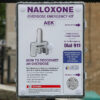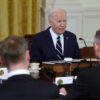President Joe Biden’s vaccine mandate for private employers often is described as requiring employees of large companies either to be vaccinated or be tested weekly.
But when you dig into the details, the mandate is far more invasive than that.
Nonvaccinated employees must wear masks, even if they are being tested weekly. Employers must maintain records of employees’ vaccination status.
Employees who lie to their employers about their vaccination status could face up to five years imprisonment, while employers who do not comply with the mandate face fines of $13,653 per violation.
The Biden administration is trying to make noncompliance with the federal government’s legally dubious vaccine mandate a dangerous proposition for employers and employees.
“We’ve been patient, but our patience is wearing thin,” Biden said in a Sept. 9 speech in which he announced the coming vaccine mandate.
The Labor Department then issued an emergency rule that requires businesses and other organizations with 100 or more employees to get a shot of the COVID-19 vaccine. The mandate is intended to supersede state laws.
The rule, set to go into effect Jan. 4., authorizes the Occupational Safety and Health Administration, an agency within the Labor Department, to enforce the vaccine mandate.
Unsurprisingly, states and employers are challenging the mandate in court. Legal scholars are raising serious constitutional questions about whether OSHA has the power to enforce such a measure.
Businesses, nonprofits, and 27 states already have launched lawsuits to stop implementation of the mandate. The 5th U.S. Circuit Court of Appeals issued an order to halt the vaccine mandate, citing “grave statutory and constitutional issues.”
But what’s going to happen Jan. 4 if Biden’s vaccine mandate goes into effect?
Here are some ways that the mandate could be enforced if it isn’t blocked by courts or otherwise stopped.
1. Employees who don’t comply must be masked and tested weekly.
The vaccine mandate allows for some employees to choose not to vaccinate. However, the mandate has strict requirements for those who opt out.
First, unvaccinated employees must wear face masks while indoors or in a vehicle with another person, “except in certain limited circumstances.”
But the mandate requires more than just masking.
Employees who are not “fully vaccinated” must be tested for COVID-19 on a weekly basis.
What counts as fully vaccinated?
A fact sheet from the White House says:
All covered employers must ensure that their employees have received the necessary shots to be fully vaccinated—either two doses of Pfizer or Moderna, or one dose of Johnson & Johnson—by Jan. 4. After that, all covered employers must ensure that any employees who have not received the necessary shots begin producing a verified negative test to their employer on at least a weekly basis.
The mandate does not make an exception for those who already have had COVID-19 and developed natural immunity. The vaccine requirement will apply to them too.
2. Only specific tests fulfill the mandate’s requirements.
Not all COVID-19 tests fulfill the requirement for the weekly testing of unvaccinated employees.
According to the Occupational Safety and Health Administration’s “frequently asked questions” guide to the mandate, the test must be “cleared, approved, or authorized, including in an Emergency Use Authorization (EUA), by the U.S. Food and Drug Administration.”
The test also must not be “both self-administered and self-read unless observed by the employer or an authorized telehealth proctor.”
The mandate requires that employees use antigen tests, not antibody tests. That is, the test must detect whether a person is currently infected with COVID-19, not whether the person had it at some point and now has antibodies.
A test that meets the mandate’s compliance standards either must be processed in a laboratory, “a proctored test that is supervised by an authorized telehealth provider,” or a test conducted by the employer itself.
3. Unvaccinated minors are subject to the same requirements.
The vaccine mandate applies to employees who are minors too. This is so despite some evidence that a vaccine may lead to myocarditis, a heart condition, in a higher proportion of teens and young adults.
For minors who are unvaccinated, the same standards of testing and masking apply as with other employees.
4. Employers must track employees’ status and enforce compliance.
Biden’s vaccine mandate requires employers to track who gets vaccinated and how.
According to an OSHA fact sheet, employers must “determine the vaccination status of each employee, obtain acceptable proof of vaccination from vaccinated employees, maintain records of each employee’s vaccination status, and maintain a roster of each employee’s vaccination status.”
In addition, the mandate requires employers to record COVID-19 test results for unvaccinated employees.
Given the limited nature of OSHA—which has a relatively small number of inspectors given the scope of compliance demands—the agency essentially will rely on whistleblowers.
“For the private employer rules, OSHA has an estimated 800 safety and compliance inspectors to cover more than 100,000 companies covered by the mandate,” Reuters reported. “The agency likely will rely on whistleblowers concerned about unvaccinated co-workers or that unvaccinated people are not being tested as required, said James Hermon, a labor and employment expert with the firm Dykema Gossett.”
5. Failure to comply could lead to big fines.
Compliance enforcement is where Biden’s vaccine mandate is at its most draconian.
Businesses that fail to comply with the mandate could be subject to hefty fines. And these wouldn’t just be blanket fines for noncompliance.
Instead, the mandate includes significant fines per violation.
The “normal” penalty is $13,653 per violation. But this applies to violations of the mandate such as not providing paid leave for employees to get a COVID-19 shot.
For willful noncompliance, companies face a maximum penalty of $136,532 per violation, or 10 times larger.
The nature and dollar amount of these fines is left to the discretion of the Occupational Safety and Health Administration.
This means that the penalties imposed could be lower than the highest amount. It also could mean that fines could be applied to each individual employee who fails to comply with the mandate.
“They [OSHA] can theoretically issue a $13,653 citation times 150 for each employee there,” Jordan Barab, former deputy assistant secretary of OSHA, said in an interview with McClatchy News. “There are ways for OSHA to issue larger penalties in certain egregious but generally rare situations.”
The fines could end up being a whole lot worse if Democrats in Congress get their way.
Biden’s “Build Back Better” social spending plan, a $1.75 trillion package under consideration in the House, would bump up the fines to $70,000 for “serious violations” and $700,000 for willful violations.
The current version of the spending bill also would give OSHA $707 million to enforce the mandate, Fox News reported.
6. Falsifying vaccination status could mean fines and imprisonment.
Individual employees who falsify statements to their employers about their vaccination status also face harsh, criminal penalties.
In fact, the penalty could end up being jail time behind bars.
OSHA’s website lays out what could happen:
Whoever knowingly makes any false statement, representation, or certification in any application, record, report, plan, or other document filed or required to be maintained pursuant to this chapter shall, upon conviction, be punished by a fine of not more than $10,000, or by imprisonment for not more than six months, or by both.
Have an opinion about this article? To sound off, please email letters@DailySignal.com and we’ll consider publishing your edited remarks in our regular “We Hear You” feature. Remember to include the url or headline of the article plus your name and town and/or state.




























